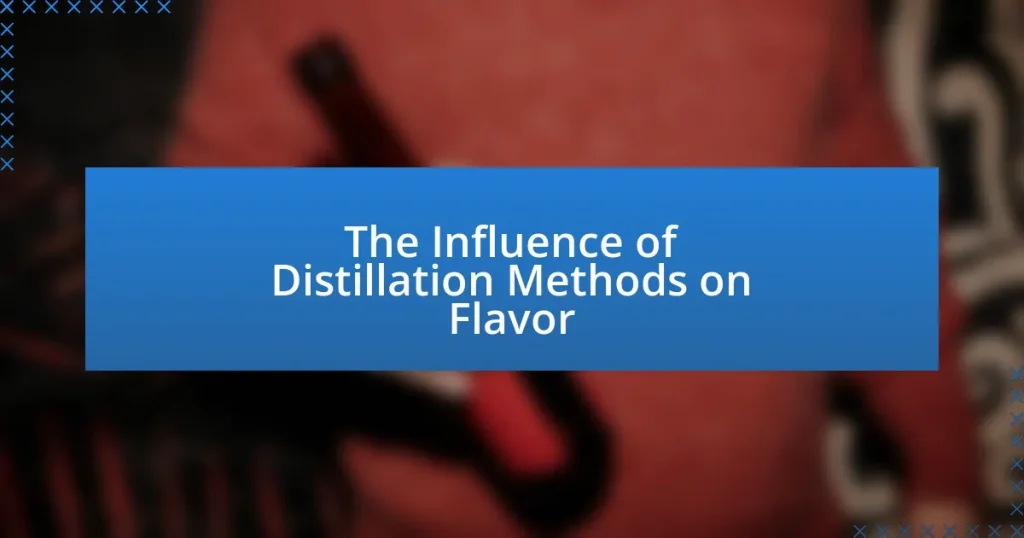The article examines the influence of various distillation methods on flavor development in spirits. It highlights how techniques such as pot still and column distillation affect the retention and separation of volatile compounds, leading to distinct aroma and taste profiles. Key distillation methods, including steam, fractional, and vacuum distillation, are discussed in relation to their impact on flavor extraction and purity. The article also addresses the significance of temperature control, source materials, and fermentation processes in shaping the final flavor outcomes, providing insights into best practices for optimizing flavor through distillation.

What is the Influence of Distillation Methods on Flavor?
Distillation methods significantly influence flavor by altering the composition of volatile compounds in the final product. Different techniques, such as pot still distillation and column distillation, affect the retention and separation of these compounds, leading to variations in aroma and taste profiles. For instance, pot still distillation typically results in a richer, more complex flavor due to the retention of heavier compounds, while column distillation produces a cleaner, more neutral spirit by removing many of these compounds. Studies have shown that the choice of distillation method can lead to distinct flavor characteristics in spirits, such as whiskey and vodka, highlighting the critical role of distillation in flavor development.
How do different distillation methods impact flavor profiles?
Different distillation methods significantly impact flavor profiles by altering the composition of volatile compounds extracted from the raw materials. For instance, pot still distillation tends to produce richer and more complex flavors due to its batch process, which retains more of the original ingredients’ characteristics. In contrast, column still distillation, which operates continuously, often results in a cleaner and lighter spirit by removing more impurities and heavier compounds. Research indicates that pot stills can enhance fruity and floral notes, while column stills may emphasize a more neutral profile, as seen in the production of vodka. This variation in flavor outcomes is supported by studies on the chemical analysis of spirits, which show distinct differences in the concentration of esters and phenols based on the distillation method used.
What are the primary distillation methods used in flavor production?
The primary distillation methods used in flavor production are steam distillation, fractional distillation, and vacuum distillation. Steam distillation is commonly employed for extracting essential oils from plant materials, as it allows for the separation of volatile compounds without degrading them. Fractional distillation is utilized to separate mixtures based on different boiling points, which is essential for producing specific flavor profiles in complex mixtures. Vacuum distillation, on the other hand, is used to distill heat-sensitive compounds at lower temperatures, preserving their integrity and flavor characteristics. These methods are critical in the food and beverage industry for creating high-quality flavors and aromas.
How does the choice of distillation method affect the final flavor?
The choice of distillation method significantly impacts the final flavor of the distilled product. Different methods, such as pot still distillation and column distillation, result in varying levels of flavor retention and purity. Pot still distillation typically preserves more of the original flavors and aromas from the raw materials due to its slower process and lower efficiency, allowing for a richer and more complex flavor profile. In contrast, column distillation, which is more efficient and produces a higher alcohol content, often strips away some of the nuanced flavors, resulting in a cleaner but less flavorful spirit. Studies have shown that spirits produced through pot still methods, like many traditional whiskies and rums, exhibit a broader range of flavor compounds compared to those produced via column distillation, which tends to yield a more neutral spirit.
Why is understanding distillation methods important for flavor development?
Understanding distillation methods is crucial for flavor development because these techniques directly influence the extraction and concentration of volatile compounds that contribute to a product’s aroma and taste. Different distillation methods, such as pot still and column distillation, vary in their ability to separate and retain specific flavor compounds. For instance, pot still distillation typically preserves more of the original flavor profile due to its slower process and lower temperatures, while column distillation can produce a purer spirit with a more neutral flavor. This relationship between distillation technique and flavor profile is supported by studies showing that variations in distillation parameters can lead to significant differences in the sensory characteristics of the final product.
What role does distillation play in the overall flavor profile of a product?
Distillation significantly influences the overall flavor profile of a product by separating volatile compounds based on their boiling points. This process allows for the extraction of desirable flavors while removing unwanted impurities and off-flavors. For example, in the production of spirits, distillation concentrates the alcohol and enhances the aromatic compounds, resulting in a more refined and complex flavor profile. Studies have shown that different distillation methods, such as pot still versus column still, can lead to variations in flavor intensity and character, thereby affecting the final product’s taste.
How can distillation methods enhance or diminish specific flavor notes?
Distillation methods can enhance or diminish specific flavor notes by controlling the temperature and pressure during the distillation process, which affects the volatility of various compounds. For instance, fractional distillation allows for the separation of components based on their boiling points, enabling the retention of desirable flavor compounds while removing unwanted ones. Research shows that different distillation techniques, such as pot still versus column still, can lead to significant variations in flavor profiles; pot stills often produce richer, more complex flavors due to their ability to retain heavier compounds, while column stills yield a purer, lighter spirit by stripping away more flavor elements. This selective retention or removal of compounds directly influences the final taste and aroma of the distilled product.

What are the key distillation methods and their flavor influences?
The key distillation methods include pot still distillation, column still distillation, and vacuum distillation, each significantly influencing flavor profiles. Pot still distillation, often used for whiskey and rum, retains more congeners, resulting in richer, fuller flavors. Column still distillation, commonly employed for vodka and gin, produces a purer spirit with lighter flavors due to its continuous process and higher efficiency in separating alcohol from impurities. Vacuum distillation, which operates at lower temperatures, preserves delicate flavors and aromas, making it ideal for high-quality spirits like certain gins and essential oils. These methods directly affect the final taste and aroma of the distilled products, shaping consumer preferences and market trends.
What are the characteristics of pot still distillation?
Pot still distillation is characterized by its ability to produce spirits with rich flavors and aromas due to the use of a single distillation process. This method involves heating the fermented mash in a pot-shaped still, allowing for a slower distillation that retains more of the original ingredients’ characteristics. The process typically results in a higher concentration of congeners, which are compounds that contribute to the flavor profile of the spirit. Additionally, pot still distillation often leads to a fuller-bodied product compared to column still distillation, as it allows for more complex flavor development. This is evidenced by the traditional production of whiskey and rum, where pot stills are favored for their ability to enhance the sensory qualities of the final product.
How does pot still distillation affect the complexity of flavors?
Pot still distillation enhances the complexity of flavors by allowing for a greater retention of volatile compounds and congeners during the distillation process. This method involves a single distillation run, which preserves more of the original character of the raw materials, such as grains or fruits, compared to column still distillation that typically results in a more neutral spirit. The pot still’s design, which includes a wider neck and less efficient separation of alcohol from impurities, enables the distillation of a richer array of flavors and aromas, contributing to a more nuanced final product. Studies have shown that spirits produced through pot still distillation often exhibit a broader spectrum of flavor profiles, including fruity, floral, and spicy notes, due to the retention of these complex compounds.
What types of spirits benefit most from pot still distillation?
Pot still distillation primarily benefits spirits such as whiskey, rum, and certain types of gin. This method allows for a slower distillation process, which enhances the extraction of flavors and aromas from the raw materials. For instance, pot stills retain more of the congeners and esters that contribute to the complex flavor profiles found in traditional Irish and Scotch whiskies. Additionally, rums produced in pot stills often exhibit richer, more robust flavors due to the retention of natural sugars and other compounds during distillation. Gin made using pot stills can also showcase a more pronounced botanical character, as the distillation process allows for a more nuanced extraction of flavors.
What is the significance of column still distillation?
Column still distillation is significant because it allows for continuous separation of components in a mixture, resulting in higher purity and efficiency compared to pot still distillation. This method utilizes a vertical column packed with trays or packing material, which facilitates multiple vaporization and condensation cycles, enhancing the separation of volatile compounds. As a result, column still distillation produces spirits with a cleaner flavor profile and higher alcohol content, which is crucial for industries aiming for consistency and quality in their products. The ability to control temperature and pressure during the process further contributes to the distinct flavors and aromas of the final product, making it a preferred method in large-scale production.
How does column still distillation create a cleaner flavor profile?
Column still distillation creates a cleaner flavor profile by allowing for continuous separation of volatile compounds during the distillation process. This method utilizes a series of plates or trays that facilitate multiple distillation stages in a single pass, effectively removing impurities and heavier compounds that contribute to off-flavors. The result is a higher purity spirit with a more refined taste, as evidenced by the ability to achieve higher alcohol concentrations and a more consistent product quality compared to pot still distillation, which often retains more congeners and flavor compounds.
What are the advantages of using column still distillation in large-scale production?
Column still distillation offers several advantages in large-scale production, primarily efficiency and consistency. This method allows for continuous operation, which significantly increases throughput compared to batch distillation. Additionally, column stills enable better separation of components due to their design, leading to higher purity levels in the final product. For instance, the ability to maintain precise temperature control throughout the column enhances the distillation process, resulting in a more refined flavor profile. Furthermore, the scalability of column stills makes them suitable for industrial applications, accommodating varying production volumes without compromising quality.
How do hybrid distillation methods influence flavor?
Hybrid distillation methods influence flavor by combining different distillation techniques to enhance the extraction of aromatic compounds while minimizing undesirable elements. These methods, such as the integration of pot still and column still processes, allow for greater control over temperature and pressure, which can lead to a more refined flavor profile. For instance, the use of pot stills can retain more complex flavors, while column stills can produce a purer spirit. Research indicates that spirits produced using hybrid methods often exhibit a balance of richness and clarity, resulting in a more nuanced taste experience.
What are the benefits of combining pot and column still techniques?
Combining pot and column still techniques enhances the distillation process by leveraging the strengths of both methods. Pot stills are known for producing rich, flavorful spirits due to their ability to retain more congeners, while column stills offer higher efficiency and purity through continuous distillation. This combination allows distillers to create spirits that maintain complex flavors while achieving desired alcohol content and clarity. For instance, using a pot still for the initial distillation captures the essence of the raw materials, and then a column still can refine the spirit, removing unwanted impurities. This dual approach results in a balanced product that showcases both depth of flavor and smoothness, appealing to a broader range of consumers.
How do hybrid methods affect the balance of flavors in spirits?
Hybrid methods enhance the balance of flavors in spirits by combining different distillation techniques, such as pot still and column still processes. This combination allows for the extraction of a wider range of flavor compounds, resulting in a more complex and nuanced profile. For example, pot still distillation retains more of the original ingredients’ character, while column still distillation provides a higher purity and consistency. The interplay between these methods can lead to spirits that exhibit both rich, bold flavors and clean, refined notes, ultimately creating a harmonious balance that appeals to diverse palates.

How do external factors influence the effectiveness of distillation methods on flavor?
External factors significantly influence the effectiveness of distillation methods on flavor by affecting the temperature, pressure, and composition of the distillation environment. For instance, variations in ambient temperature can alter the boiling points of compounds, leading to different flavor profiles in the final product. Additionally, pressure changes can impact the volatility of flavor compounds, with lower pressures often enhancing the extraction of delicate flavors. Furthermore, the presence of impurities or different feedstock compositions can also modify the distillation outcome, as certain compounds may interact differently under varying conditions. These factors collectively determine the efficiency and quality of flavor extraction during the distillation process.
What role does temperature play in distillation and flavor extraction?
Temperature is crucial in distillation and flavor extraction as it determines the volatility of compounds. Higher temperatures increase the vaporization of volatile flavor compounds, allowing them to be separated from the mixture. For instance, during distillation, specific temperature ranges are maintained to selectively evaporate desired components while leaving behind less volatile substances. This selective evaporation is essential for preserving the intended flavor profile, as different compounds have varying boiling points. Research indicates that precise temperature control can enhance flavor extraction efficiency, ensuring that the final product retains the desired aromatic qualities.
How does varying temperature impact the distillation process?
Varying temperature significantly impacts the distillation process by altering the volatility of components in the mixture. Higher temperatures increase the vaporization rate of more volatile substances, allowing them to be separated more efficiently, while lower temperatures favor the retention of less volatile compounds. This temperature control is crucial in flavor distillation, as it determines which flavor compounds are captured in the distillate. For instance, in the production of essential oils, specific temperature ranges are maintained to ensure that delicate aromatic compounds are preserved, preventing degradation or loss. Studies have shown that precise temperature management can enhance the quality and complexity of flavors extracted during distillation, thereby influencing the final product’s sensory characteristics.
What are the effects of temperature on flavor volatility during distillation?
Temperature significantly affects flavor volatility during distillation by influencing the evaporation rates of volatile compounds. Higher temperatures generally increase the volatility of flavor compounds, leading to a greater release of aromatic substances. For instance, studies have shown that essential oils and flavor compounds have specific boiling points; when the distillation temperature exceeds these points, the compounds vaporize more readily, enhancing flavor extraction. Conversely, lower temperatures may preserve delicate flavors but can result in incomplete extraction of more volatile components. This relationship between temperature and flavor volatility is crucial for optimizing distillation processes to achieve desired flavor profiles in products such as spirits and essential oils.
How does the source material affect flavor outcomes in distillation?
The source material significantly affects flavor outcomes in distillation by contributing unique compounds that influence the final product’s aroma and taste. For instance, the type of grain used in whiskey production, such as barley or corn, imparts distinct flavor profiles due to the varying levels of sugars and phenolic compounds present in each grain. Research indicates that the fermentation process, which is influenced by the source material, also plays a crucial role in developing flavor compounds; for example, yeast strains interact differently with various sugars, leading to diverse esters and phenols that shape the spirit’s character. Additionally, the botanical ingredients in gin, such as juniper or citrus peels, directly affect the aromatic qualities of the distillate, showcasing how the source material is integral to flavor development.
What types of raw materials yield the best flavor profiles when distilled?
Fruits, grains, and botanicals yield the best flavor profiles when distilled. Fruits like grapes and apples provide rich, complex flavors, as seen in brandy and applejack, respectively. Grains such as barley and corn contribute distinct characteristics, evident in whiskey and bourbon production. Botanicals, particularly herbs and spices, enhance spirits like gin, where juniper and coriander create unique taste experiences. The diversity in flavor profiles from these raw materials is supported by their chemical compositions, which include esters, phenols, and terpenes that develop during fermentation and distillation processes.
How do different fermentation processes influence the distillation results?
Different fermentation processes significantly influence distillation results by altering the composition of volatile compounds and the overall flavor profile of the final product. For instance, yeast strains used during fermentation can produce varying levels of esters, phenols, and higher alcohols, which directly affect the aroma and taste of the distilled spirit. Research indicates that specific yeast strains, such as Saccharomyces cerevisiae, can enhance fruity notes, while wild fermentation may introduce complex, earthy flavors due to the presence of diverse microorganisms. Additionally, fermentation temperature and duration can impact the metabolic pathways of yeast, leading to different concentrations of flavor compounds. These variations ultimately result in distinct sensory characteristics in the distilled product, demonstrating the critical role of fermentation in shaping flavor outcomes.

What are best practices for optimizing flavor through distillation methods?
Best practices for optimizing flavor through distillation methods include selecting the appropriate distillation technique, controlling temperature precisely, and utilizing high-quality raw materials. The choice of distillation method, such as pot still or column still, significantly impacts flavor extraction; pot stills are known for producing richer, more complex flavors due to their batch processing and lower distillation speeds. Precise temperature control is crucial, as it ensures that desirable volatile compounds are retained while undesirable ones are removed; for instance, maintaining a lower temperature during the initial distillation phase can help capture delicate aromatic compounds. Additionally, using high-quality raw materials, such as fresh botanicals or premium grains, enhances the overall flavor profile, as the quality of the input directly influences the final product. These practices are supported by industry standards and research indicating that the distillation process is a critical factor in flavor development, as seen in studies on spirits and essential oils.
How can distillers choose the right method for desired flavor outcomes?
Distillers can choose the right method for desired flavor outcomes by evaluating the specific characteristics of each distillation technique, such as pot still versus column still, and understanding how these methods influence the extraction of flavor compounds. Pot stills, for example, allow for a slower distillation process that retains more of the original flavors from the raw materials, resulting in a richer and more complex spirit. In contrast, column stills provide a more efficient and higher purity distillation, which can lead to a cleaner taste but may strip away some of the nuanced flavors. Research indicates that the choice of distillation method significantly impacts the final flavor profile, as evidenced by studies showing that spirits distilled in pot stills often exhibit more pronounced fruity and floral notes compared to those produced in column stills. Therefore, distillers should align their method with the desired flavor profile by considering the raw materials, the intended spirit style, and the sensory attributes they wish to emphasize.
What factors should be considered when selecting a distillation method?
When selecting a distillation method, factors such as the boiling point of the components, the desired purity level, and the thermal sensitivity of the substances must be considered. The boiling point influences the efficiency of separation, as different methods are optimized for specific temperature ranges. The desired purity level dictates the complexity of the distillation process; for instance, fractional distillation is preferred for high-purity requirements. Additionally, the thermal sensitivity of the components affects the choice of method, as some substances may degrade at high temperatures, necessitating gentler techniques like steam distillation. These considerations ensure that the chosen method effectively preserves the flavor profile of the distilled product.
How can experimentation with distillation methods enhance flavor development?
Experimentation with distillation methods can enhance flavor development by allowing distillers to manipulate variables such as temperature, pressure, and the type of still used. Different distillation techniques, such as pot stills versus column stills, can extract varying compounds from the raw materials, leading to distinct flavor profiles. For instance, pot stills typically produce richer, more complex flavors due to their batch processing and lower distillation efficiency, which retains more congeners. In contrast, column stills offer higher purity and can create lighter, cleaner spirits by removing more impurities. Research has shown that adjusting the distillation temperature can significantly influence the retention of volatile compounds, which are crucial for flavor. A study published in the Journal of Agricultural and Food Chemistry demonstrated that specific temperature profiles during distillation can enhance desirable flavor compounds while minimizing unwanted ones, thus confirming that experimentation in distillation methods directly impacts flavor development.
What common challenges do distillers face in achieving desired flavors?
Distillers commonly face challenges such as controlling temperature, managing fermentation, and selecting raw materials to achieve desired flavors. Temperature control during distillation is crucial, as variations can lead to unwanted compounds affecting flavor profiles. Additionally, fermentation management is essential; yeast strains and fermentation conditions significantly influence the flavor development in the final product. Lastly, the choice of raw materials, including grains or fruits, directly impacts the flavor outcome, as different ingredients contribute unique characteristics to the spirit. These challenges highlight the complexity of flavor development in distillation processes.
How can distillers troubleshoot flavor inconsistencies during distillation?
Distillers can troubleshoot flavor inconsistencies during distillation by closely monitoring temperature, fermentation quality, and raw material characteristics. Temperature control is crucial, as fluctuations can lead to unwanted compounds affecting flavor profiles. For instance, maintaining a consistent distillation temperature ensures that the desired volatile compounds are captured while minimizing the extraction of undesirable flavors. Additionally, assessing the quality of fermentation is essential; off-flavors can arise from stressed yeast or improper fermentation conditions. Lastly, the choice and quality of raw materials, such as grains or fruits, directly influence the final flavor. By systematically evaluating these factors, distillers can identify and rectify sources of flavor inconsistencies, ensuring a more consistent product.
What strategies can be employed to refine flavor profiles through distillation?
To refine flavor profiles through distillation, one effective strategy is the use of fractional distillation, which allows for the separation of volatile compounds based on their boiling points. This method enables distillers to isolate specific flavor components, enhancing the overall complexity and character of the final product. For instance, in the production of whiskey, distillers can selectively retain desirable esters and phenols while removing unwanted impurities, resulting in a more refined flavor profile. Additionally, the choice of distillation apparatus, such as pot stills versus column stills, significantly impacts flavor retention; pot stills tend to preserve more of the original character of the raw materials, while column stills can produce a cleaner, more neutral spirit. These strategies are supported by the fact that distillation parameters, including temperature and pressure, can be precisely controlled to optimize the extraction of specific flavors, thereby influencing the sensory attributes of the distilled product.


